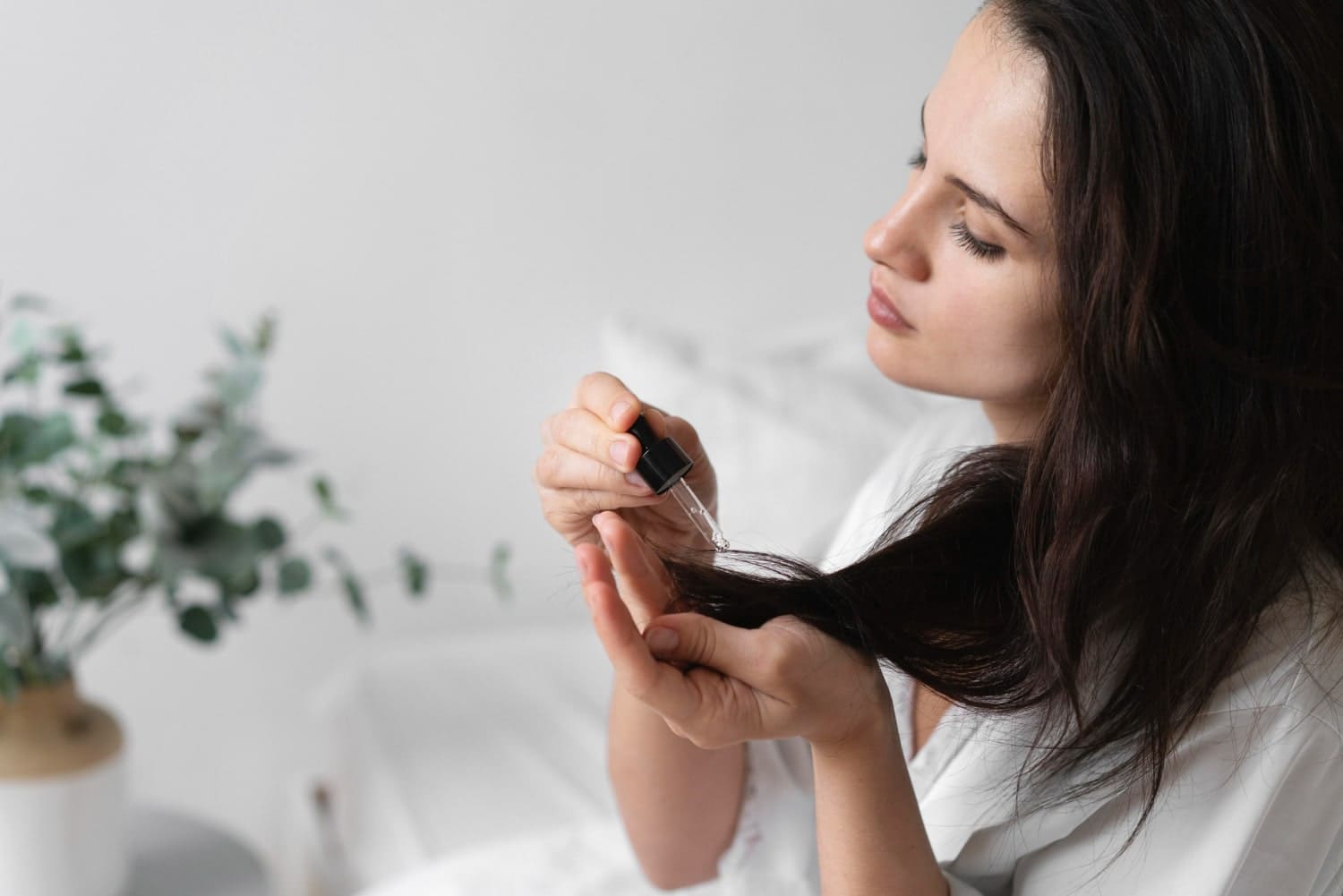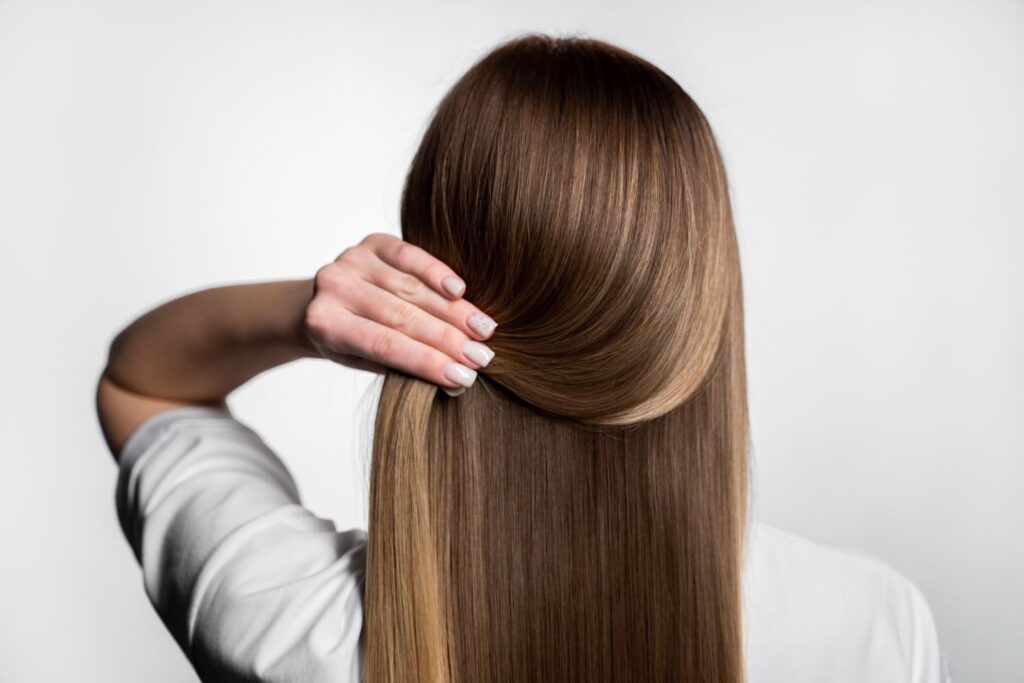Hair problems got you down? The solution might be hiding in your kitchen. Vitamin A stands as that behind-the-curtain performer for your hair’s daily show. From cellular regeneration to natural conditioning, this nutrient supports both strength and length, qualities we all desire, but few truly understand how to achieve.
How Does Vitamin A Make My Hair Grow?
The intricate process of your hair’s growth cycle relies on specific cellular signals, with vitamin A for hair growth playing the role of crucial messengers that guide this process.
At the molecular level, this nutrient transforms into retinoic acid, which then:
- Binds to nuclear receptors within follicle cells
- Triggers the expression of genes controlling proliferation
- Regulates the pace of keratin production
- Determines how long hair remains in active growth phases
Unlike other nutrients that support hair peripherally, vitamin A directly influences the differentiation of stem cells into hair-producing cells. This specificity explains why deficiencies so quickly manifest as visible changes in hair quality and growth rate.
The protein assembly that occurs during strand formation requires precise coordination. When cells receive proper vitamin A signaling, they create more orderly protein structures. These tightly aligned keratin formations resist damage better than the disorganized patterns formed during deficiency states.
Clinical observations confirm this connection. Individuals experiencing unexplained slowdowns in hair growth frequently show improved results when addressing insufficient vitamin A levels, not through megadoses, but by reaching optimal ranges that support cellular function.
The Role of Vitamin A in Natural Hair Oil Production
Beneath visible strands lies the true foundation of hair health: your scalp. Here, vitamin A produces a delicate balance of natural oils that commercial products can only imitate.
Squalene helps to moisturize the skin without feeling heavy and optimizes production levels, ensuring the skin maintains its balance.
Wax esters form a protective barrier on the skin, ensuring proper molecular composition and preventing harmful elements from affecting the skin.
Triglycerides deliver fat-soluble nutrients to the skin and regulate lipid metabolism, supporting healthy skin function.
Free fatty acids help maintain an acidic protective barrier, which in turn controls antimicrobial properties, offering a defense against external threats.
The specialized glands attached to your follicles respond directly to vitamin A metabolites. These cells must produce enough sebum to nourish both scalp and hair without causing buildup or blockages.
When functioning optimally, this natural oil system creates what stylists refer to as “virgin hair quality” – strands with natural slip, elasticity, and reflective properties. Many hair products attempt to recreate these conditions artificially, yet nothing quite matches your body’s custom formulation.
Environmental factors like seasonal changes and water quality interact with your sebum production. The adaptability of this system depends partly on adequate vitamin A, which helps sebaceous glands respond appropriately to changing conditions rather than remaining static. Maintaining this balance is crucial for healthy hair, ensuring your scalp’s natural oils remain in perfect harmony.
What Are the Risks of Vitamin A Imbalance for My Hair?
Hair health exists within a narrow nutritional window, particularly regarding vitamin A. This nutrient demonstrates what biochemists call a “U-shaped curve effect,” where both insufficient and excessive levels create similar negative outcomes through entirely different mechanisms.
When deficiency develops, you might notice:
- Hair that grows more slowly month by month
- Increasing brittleness when styling
- Scalp flaking despite moisturizing attempts
- Strands that appear thinner at the roots
- Lackluster appearance regardless of the products used
The scientific explanation involves cellular communication networks. Vitamin A and hair loss connect when retinoid levels fall below thresholds needed for proper gene expression. Without these signals, follicle stem cells remain dormant longer than optimal or differentiate improperly, leading to structural weaknesses in newly formed hair.
Counterintuitively, excessive intake, most commonly from supplement misuse, creates a mirror-image problem. Hypervitaminosis A accelerates follicle cycling beyond sustainable rates, exhausting the cells’ regenerative capacity. This acceleration manifests as:
- Diffuse shedding across the scalp
- Breakage along the hair shaft
- Scalp tenderness when touched
- Concurrent skin changes like dryness
- Paradoxical thinning despite attempts to support growth
Medical literature documents this relationship between vitamin A and hair loss in numerous case studies of patients taking high-dose supplements. Restoration typically occurs when levels normalize, highlighting the reversible nature of this condition when addressed promptly.
Standard blood tests can determine your status before visible symptoms develop. Most adults require approximately 700-900 mcg daily, quantities readily available through varied diets without supplementation except in specific medical circumstances.
Nourishing Your Hair with Vitamin A-Rich Foods

The most reliable and safest method for ensuring adequate vitamin A involves strategic food choices rather than supplements. This nutrient exists in two complementary forms:
Retinoids (preformed vitamin A)
These animal-derived compounds provide immediate benefits because they enter your bloodstream ready to use, typically absorbing at 70-90% efficiency and binding directly to hair follicle receptors without requiring conversion. Exceptional retinoid sources include:
- Grass-fed beef liver (6,582 mcg RAE per 3 oz serving)
- Pasture-raised egg yolks (80 mcg RAE per whole egg)
- Organic butter from grass-fed cows (97 mcg RAE per tablespoon)
- Wild-caught salmon (149 mcg RAE per 3 oz portion)
Carotenoids (provitamin A)
These abundant plant pigments offer a safer approach to vitamin A intake through their self-regulating absorption mechanism, converting to active forms only when your body signals a need, preventing potential toxicity issues. For plant-based options, particularly beta-carotene-rich foods:
- Organic sweet potatoes (1,403 mcg RAE per medium baked)
- Heirloom carrots (1,069 mcg RAE per cup, raw)
- Local spinach (573 mcg RAE per cup, cooked)
- Freshly harvested red bell peppers (117 mcg RAE per medium pepper)
- Tree-ripened mango (89 mcg RAE per cup, sliced)
The enzymatic conversion of carotenoids to active vitamin A operates through negative feedback mechanisms – slowing as levels rise and accelerating when stores fall. This biological safety feature explains why food sources rarely cause toxicity problems observed with synthetic supplements.
Preservation techniques impact nutrient levels significantly. Light steaming vegetables rather than boiling or microwaving retains up to 25% more vitamin A compounds. Similarly, consuming fresh produce within days of purchase maximizes potential benefits before natural degradation occurs.
Should I Consider Liquid Vitamin A for My Hair?
The cosmetic industry has harnessed vitamin A derivatives for topical use, creating specialized liquid vitamin A for hair treatments. These formulations work through different mechanisms than dietary sources.
Most liquid vitamin A for hair products contain retinol or retinyl palmitate in concentrations ranging from 0.05% to 2%. These molecules can penetrate the stratum corneum of the scalp, where they influence:
- Cellular turnover rates in the outer dermis
- Sebaceous gland activity and composition
- Local circulation patterns around follicles
- Inflammatory mediator production by resident immune cells
For maximum effectiveness, look for products containing 0.1-1% active retinol concentrations clinically shown to produce benefits without excessive irritation. Products listing “retinol” after the fifth ingredient likely contain insufficient amounts for measurable results.
Complementary ingredients in quality liquid vitamin A for hair formulations include:
- Niacinamide (vitamin B3) to enhance penetration
- Hyaluronic acid for moisture retention
- Peptide complexes supporting cellular repair
- Antioxidants preventing compound degradation
Application technique significantly impacts results. Rather than coating hair strands, these products require direct scalp contact and gentle massage to stimulate microcirculation. Treatment frequency matters too – twice weekly application typically balances results against potential irritation better than daily use.
Topical treatments offer particular advantages for individuals with specific scalp conditions or those seeking targeted solutions without systemic effects. They work most effectively when used alongside proper nutrition, addressing the issue from both external and internal perspectives for comprehensive results.
The Synergy of Nutrients for Healthy Hair Growth

While vitamin A for hair provides fundamental benefits, it functions optimally within a broader network of supportive factors.
Nutritional Synergists
- Iron carries oxygen needed for follicle metabolism
- Zinc enables protein synthesis and cell division
- Biotin facilitates carbon dioxide transfer in keratin production
- Omega-3 fatty acids moderate inflammatory responses at the follicle level
- Vitamin E neutralizes free radicals that damage newly forming cells
Physical Care Practices
- Brushing with natural bristles distributes sebum without static damage
- Protective styling minimizes mechanical stresses on fragile strands
- Heat application with protective barriers prevents protein denaturation
- Appropriate pillow materials reduce friction during sleep
- Strategic trimming removes damaged sections before splitting progresses
Environmental Considerations
- Protection from ultraviolet radiation prevents protein cross-linking
- Water filtration reduces mineral buildup on the hair shaft
- Humidity-appropriate styling products prevent moisture imbalance
- Anti-pollution barriers shield against particulate adhesion
- Swimming protection prevents chlorine and salt damage
These elements create a comprehensive system where vitamin A can perform its specialized functions without compensating for deficiencies in other areas. For personalized recommendations tailored to your specific hair characteristics, consulting with specialists at HairSocial provides access to customized protocols based on professional assessment.
The Long-Term Benefits of Vitamin A for Your Hair
Understanding how vitamin A impacts your hair’s cellular function, from keratin production to scalp health, is the crucial first step towards achieving the stronger, more vibrant locks you desire. A consistent, balanced diet, rich in this vital nutrient, provides the essential building blocks for this progress from within. To truly amplify these benefits and experience the ultimate in hair care, why not Treat Yourself to professional treatments? Skilled stylists can offer targeted therapies, from deep conditioning to scalp treatments, that work in synergy with your improved nutrition to further enhance your hair’s natural beauty and resilience.

